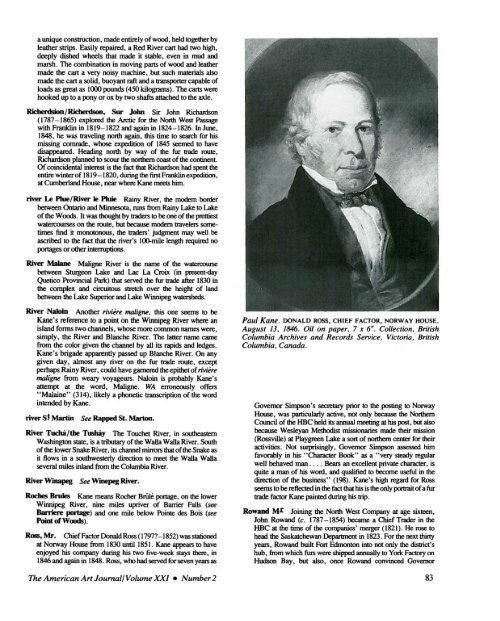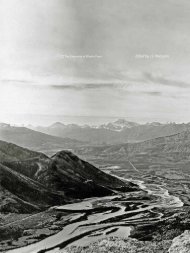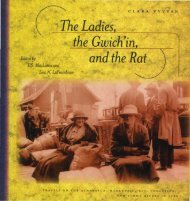Paul Kane's Journal of his Western Travels, 1846-1848 - History and ...
Paul Kane's Journal of his Western Travels, 1846-1848 - History and ...
Paul Kane's Journal of his Western Travels, 1846-1848 - History and ...
You also want an ePaper? Increase the reach of your titles
YUMPU automatically turns print PDFs into web optimized ePapers that Google loves.
a unique construction, made entirely <strong>of</strong> wood, held together by<br />
leather strips. Easily repaired, a Red River cart had two high,<br />
deeply dished wheels that made it stable, even in mud <strong>and</strong><br />
marsh. The combination in moving parts <strong>of</strong> wood <strong>and</strong> leather<br />
made the cart a very noisy machine, but such materials also<br />
made the cart a solid, buoyant raft <strong>and</strong> a transporter capable <strong>of</strong><br />
loads as great as 1000 pounds (450 kilograms). The carts were<br />
hooked up to a pony or ox by two shafts attached to the axle.<br />
Richerdsion/Richerdson, Sur John Sir John Richardson<br />
(1787- 1865) explored the Arctic for the North West Passage<br />
with Franklin in 1819- 1822 <strong>and</strong> again in 1824- 1826. In June,<br />
<strong>1848</strong>, he was traveling north again, t<strong>his</strong> time to search for <strong>his</strong><br />
missing corruade, whose expedition <strong>of</strong> 1845 seemed to have<br />
disappeared. Heading north by way <strong>of</strong> the fur trade route,<br />
Richardson planned to scour the northern coast <strong>of</strong> the continent.<br />
Of coincidental interest is the fact that Richardson had spent the<br />
entire winter <strong>of</strong> 1819-1820, during the first Franklin expedition,<br />
at Cumberl<strong>and</strong> House, near where Kane meets him.<br />
river Le PIne/River Ie PIuie Rainy River, the modem border<br />
between Ontario <strong>and</strong> Minnesota, runs from Rainy Lake to Lake<br />
<strong>of</strong> the Woods. It was thought by traders to be one <strong>of</strong> the prettiest<br />
watercourses on the route, but because modem travelers sometimes<br />
find it monotonous, the traders' judgment may well be<br />
ascribed to the fact that the river's I ~mile length required no<br />
portages or other interruptions.<br />
River MaIane Maligne River is the name <strong>of</strong> the watercourse<br />
between Sturgeon Lake <strong>and</strong> Lac La Croix (in present-day<br />
Quetico Provincial Park) that served the fur trade after 1830 in<br />
the complex <strong>and</strong> circuitous stretch over the height <strong>of</strong> l<strong>and</strong><br />
between the Lake Superior <strong>and</strong> Lake Winnipeg watersheds.<br />
River Naloin Another riviere maligne, t<strong>his</strong> one seems to be<br />
<strong>Kane's</strong> reference to a point on the Winnipeg River where an<br />
isl<strong>and</strong> fonns two channels, whose more common names were,<br />
simply, the River <strong>and</strong> Blanche River. The latter name came<br />
from the color given the channel by all its rapids <strong>and</strong> ledges.<br />
<strong>Kane's</strong> brigade apparently passed up Blanche River. On any<br />
given day, almost any river on the fur trade route, except<br />
perhaps Rainy River, could have garnered the epithet <strong>of</strong> riviere<br />
maligne from weary voyageurs. Naloin is probably <strong>Kane's</strong><br />
attempt at the word, Maligne. WA erroneously <strong>of</strong>fers<br />
"Malaine" (314), likely a phonetic transcription <strong>of</strong> the word<br />
intended. by Kane.<br />
river S! Martin See Rapped St. Marton.<br />
River Tuch3/tbe Tush8y The Touchet River, in southeastern<br />
Washington state, is a tributary <strong>of</strong> the Walla Walla River. South<br />
<strong>of</strong> the lower Snake River, its channel mirrors that <strong>of</strong> the Snake as<br />
it flows in a southwesterly direction to meet the Walla Walla<br />
several miles inl<strong>and</strong> from the Columbia River.<br />
River Winapeg See Winepeg River.<br />
Roches Brules Kane means Rocher Bnile portage, on the lower<br />
Winnipeg River, nine miles upriver <strong>of</strong> Barrier Falls (see<br />
Barriere portage) <strong>and</strong> one mile below Pointe des Bois (see<br />
Point <strong>of</strong> Woock).<br />
R~, Mr. Chief Factor Donald Ross (17'n? - 1852) was stationed<br />
at Norway House from 1830 until 1851. Kane appears to have<br />
enjoyed <strong>his</strong> company during <strong>his</strong> two five-week stays there, in<br />
<strong>1846</strong> <strong>and</strong> again in <strong>1848</strong>. Ross, who had served for seven years as<br />
The American Art lournal/ Volume XXI • Number 2<br />
<strong>Paul</strong> Kane. DONALD ROSS, CHIEF FACTOR, NORWAY HOUSE.<br />
August 13, <strong>1846</strong>. Oil on paper, 7 x 6". Collection, British<br />
Columbia Archives <strong>and</strong> Records Service, Victoria, British<br />
Columbia, Canada.<br />
Governor Simpson's secretary prior to the posting to Norway<br />
House, was particularly active, not only because the Northern<br />
COWlcil <strong>of</strong> the HBC held its annual meeting at <strong>his</strong> post, but also<br />
because Wesleyan Methodist missionaries made their mission<br />
(Rossville) at Playgreen Lake a sort <strong>of</strong> northern center for their<br />
activities. Not swprisingly, Governor Simpson assessed him<br />
favorably in <strong>his</strong> "Character Book" as a "very steady regular<br />
well behaved man .... Bears an excellent private character, is<br />
quite a man <strong>of</strong> <strong>his</strong> woni, <strong>and</strong> qualified to become useful in the<br />
direction <strong>of</strong> the business" (198). <strong>Kane's</strong> high regard for Ross<br />
seems to be reflected in the fact that <strong>his</strong> is the only portrait <strong>of</strong> a fur<br />
trade factor Kane painted during <strong>his</strong> trip.<br />
Row<strong>and</strong> MJ: Joining the North West Company at age sixteen,<br />
John Row<strong>and</strong> (c. 1787 -1854) became a Chief Trader in the<br />
HBC at the time <strong>of</strong> the companies' merger (1821). He rose to<br />
head the Saskatchewan Department in 1823. For the next thirty<br />
years, Row<strong>and</strong> built Fort Edmonton into not only the district's<br />
hub, from which fws were shipped annually to York Factory on<br />
Hudson Bay, but also, once Row<strong>and</strong> convinced Governor<br />
83
















